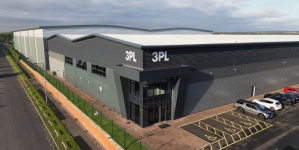-
LiftEx 2025 live from Liverpool - 9 hours ago
-
DATA ANALYSIS – THE FOUNDATION OF EVERY PEAK SEASON - December 5, 2025
-
Creative education specialists Creative Hut give 3PL full marks for onboarding excellence - December 5, 2025
-
Unlimited Industries raises $12M to build the AI construction company that will power America’s future - December 4, 2025
-
Scottish Leather Group gets full-support solution from Rushlift - December 4, 2025
-
Etaily lands strategic investment from Japan’s SMBC – bringing total funding to $24M for Social Commerce enablement platform - December 4, 2025
-
Winners lift their LEEA Awards and raise the industry - December 4, 2025
-
Prism eLogistics and Brand Angels Partnership Gives Brands the Full Package - December 3, 2025
-
New data shows Tesla in danger of losing its way as European consideration to buy Chinese cars jumps 16% in 12 months - December 3, 2025
-
QUECLINK DEVELOPS SATELLITE-ENABLED VEHICLE TRACKING FOR UNINTERRUPTED TRANSPORT MANAGEMENT - December 3, 2025
What’s Trending Now: Top Warehouse Technologies.
By Evan Garber, CEO, EVS
I was listening to the radio the other day and a song came on with the refrain that said what doesn’t kill you makes you stronger. That reminds me of the state of the supply chain and, more specifically, warehouse industry today.
It has become harder to keep up with changing consumption behaviors. Companies have had to become better and faster in every facet of their supply chain to stay ahead of global competition. However, in the end, companies are innovating new ways to improve, making them stronger, more flexible, and nimbler.
But there are two types of innovation: one is proactive innovation to lead an industry forward and the other is necessitated innovation spawned by something outside of an organization’s control. Looking at the latest trends in the supply chain sector, both kinds of innovation are front and center.
Technology takes the lead
If the supply chain was a world tour, then technology would be headlining and taking center stage. At the same time, the latest and greatest technology might not deliver exactly what you think.
Faster throughput is obvious. Ever since Amazon set the bar with its two-day shipping, consumers’ expectations have changed. They order something today and get it in a couple of days, faster than they ever have before. This change affects everyone. If you are fulfilling for Amazon, you must get that shipment out faster than ever before. Having an optimized warehouse is no longer an option; it’s a necessity.
In response, companies are innovating so that they aren’t missing revenue opportunities. A main trend in logistics and warehouse management is expanding the role of automatization and automated devices. In the warehouse, order picking accounts for 55% of the warehouse’s total operating costs, so an obvious opportunity is to optimize human labor with automation.
Artificial intelligence (AI) is another key tech trend in warehouse management and is an example of proactive innovation that has endless potential. By using exhaustive data collection combined with complex analysis, insights and correlations are being discovered that were invisible to even the most experienced warehouse manager. With AI, supply chain executives who have been with a specific business for decades are seeing certain dots connected for the first time.
We were recently working with a discount retail organization that buys seconds and last year’s styles then sells them for great discounts. They were adamant that their inventory was completely random, the 80/20 rule did not apply to them and ran their warehouse based on that assumption. After running their operations through our optimizer, we noticed that 80% of their sales were made by females with shoe sizes seven to nine and they sold three times more black than any other color. With this knowledge, they could optimize their warehouse by nearly 40%. The same type of patters and potential savings can be found whether you selling shoes or cell phones.
Whatever you are selling, the warehouse of today must be optimized to move inventory with fewer footsteps and redundancies. Margins can be eaten alive through inefficient warehouse design that causes workers to spend an unnecessary amount of time pulling product. Simply restructuring the warehouse based on pulling and shipping insights – not intuition – can turn loss centers (like newly launched ecommerce for manufacturers) into profit generators.
The Millennial Effect
With Millennials outnumbering Baby-Boomers and now making up the 20 to 36-year-old demographic, they are an influential bunch. On one hand, they’re one of the most important group of consumers. Their consumption behaviors affect the way companies make products and develop software. After all, there are 80 million of them in the US and they spend $600 billion annually. That accounts for 28% of all daily per-person consumer spending (that number will jump to 35% by 2030).
The way they are spending that money is important. About a third of millennials make most their purchases on a desktop computer while another 16% make most their purchases on their smart phone. That means about half of all millennials make most of their purchases online! Online shopping and expected expedited order fulfillment means that the entire supply chain feels this heat. To avoid becoming irrelevant, or even bankrupt, many manufacturers are having to embrace ecommerce and other direct-to-consumer channels to augment shrinking margins and meet the short shipping requirements of this group.
This is a complete overhaul of their supply chain, but not the only challenge presented by millennials.
In the supply chain, the work force is getting younger. By 2020, millennials will make up about half of the workforce and just like every other industry, supply chain companies have to accommodate them. One point to consider is that while millennials are digital natives, they also don’t want to carry around multiple devices (camera, phone, and music player). They expect their iPhone to be their Swiss army knife and their software to be smart and easy to use.
And, if the visuals get in the way of using it (i.e. something ugly like in the days of old when Telnet or DOS-based software was king), they simply will opt for a more aesthetic option. This means that the tools they’re asked to use in the workplace need to be designed and developed accordingly. No ugly spreadsheets or three separate bulky devices to complete one task. Instead, ruggedized consumer devices like iPhones with a LifeProof case paired with enterprise platforms that look like their favorite app is the next major change in the industry.
Time to thrive
Roughly 60% of goods purchased in the US are made overseas, but since North American distributors are setting the bar higher and higher in supply-chain speed and efficiency to meet the demand of consumer consumption behavior, the US is leading the trend in warehouse management innovation with technologies to stay ahead. But it won’t be long before the rest of the world catches up.
As customers expect a tighter fulfillment timeframe, technologies like AI and automatization will continue to be instrumental in helping distributors solve the problem, and positively impact their bottom line.
I started with a song, so it’s only fitting that I end with one. One of the top jazz musicians of all time says it best, “It’s not the note you play that’s the wrong note – it’s the note you play afterwards that makes it right or wrong.” (thank you Miles Davis). In other words, what you have been doing is fine (you’re still in business), but it’s what you do right now that determines if you stay that way.
Companies that anticipate these fluid changes in the supply chain industry and warehouse management can stay one step ahead, but they need to take action by identifying the best technologies for their business.
First published at: http://www.ebnonline.com/author.asp?section_id=4029&doc_id=282815&page_number=1























